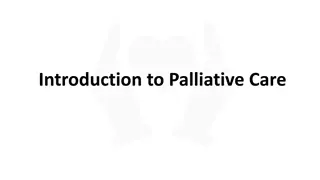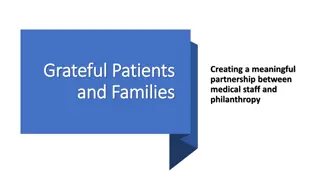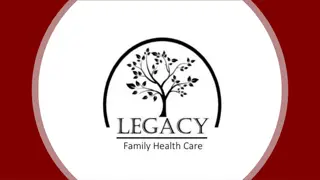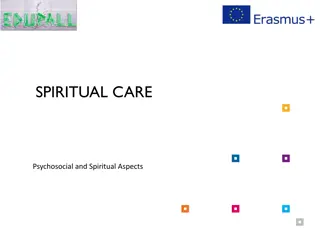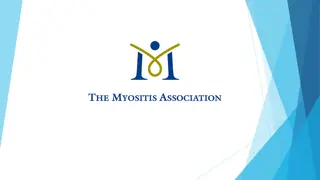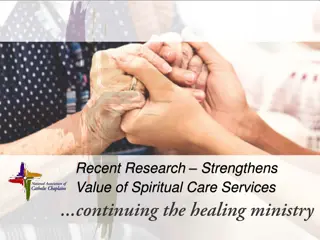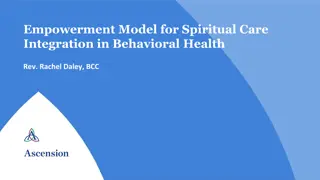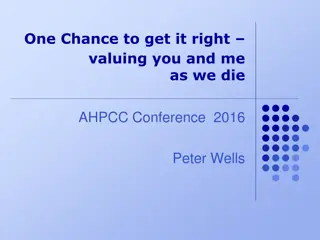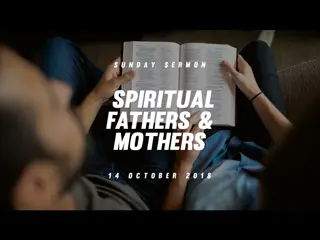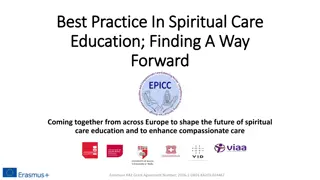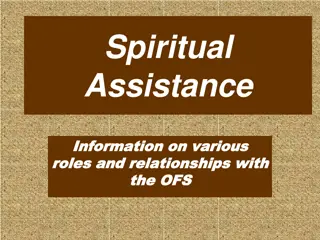Understanding the Role of Spiritual Care Partners in Healthcare
Exploring the essential role of Spiritual Care Partners within healthcare settings, this content delves into their responsibilities, including routine visits, referrals for end-of-life circumstances, and maintaining professional boundaries. Emphasizing the need for spiritual connection and support for patients, it highlights the unique contributions these partners make to holistic patient care.
Download Presentation

Please find below an Image/Link to download the presentation.
The content on the website is provided AS IS for your information and personal use only. It may not be sold, licensed, or shared on other websites without obtaining consent from the author. Download presentation by click this link. If you encounter any issues during the download, it is possible that the publisher has removed the file from their server.
E N D
Presentation Transcript
Introduction to Role of Spiritual Care Partner Spiritual Care Partners
Bon Secours Mercy Health Formerly Bon Secours Health System; now merged with Mercy Health Catholic Health System Mission Statement: We extend the compassionate ministry of Jesus by improving the health and well-being of our communities and bring good help to those in need, especially people who are poor, dying, and underserved. Values: Human Dignity, Integrity, Compassion, Stewardship, Service Our Structure: Mission Department of Bon Secours Mercy Richmond Spiritual Care Services Inpatient Pastoral Care Chaplains Volunteers (Spiritual Care Partners and others)
Educational Approach The form of education which most changes people in lasting ways has to touch them at a broader level than the thinking, reading mind can do. Some call it integrative education, transformative education, or even lifestyle education. Somehow we need to engage in hands-on experience, emotional risk-taking, moving outside of our comfort zones, with different people than our usual flattering friends. We need some expanded level of spiritual seeing or nothing really changes at a cellular or emotional level.
Within minutes or hours of entertaining a new idea, we quickly return to our old friends, our assured roles, our familiar neural grooves, our ego patterns of response, and we are back to business as usual. It is as if we never read the latest book or listened to the most recent lecture or sermon. It is merely another consumer object which we can now add to our repertoire and r sum . Done that! instead of Let it be done unto me. Richard Rohr, www.cac.org
Role and Responsibilities Primary role is to do routine initial visits on non-critical units No End-of-Life Patients May encounter end-of-life circumstances that should be referred to a chaplain immediately No Behavioral Health Patients Follow-up visits: you are welcome to follow up with patients you have already seen (provided the circumstance does not require intervention by a chaplain). Request a chaplain s permission to do so.
Role and Responsibilities Spiritual Care Partners do not attend Interdisciplinary Rounds or Family/Physician conferences, even if you are invited to be involved by another staff member. Do not contact patients/families once your shift is over and after the patient has been discharged from the hospital. Maintain appropriate professional boundaries. Your ministry is ministry within the hospital walls. If further assistance with resources is needed, refer the case to a chaplain. If a patient asks you to contact family on her/his behalf, refer this request to the patient s nurse.
Partnership with Chaplains On any given day (7 days/week), you will have the support of the hospital chaplains. Chaplains are point persons for all referrals and crises that day. To page a chaplain, call: 804-287-PRAY(7729)
Daily Procedure Each hospital has a different procedure for how your shift begins. It will likely start with signing in and picking up the list of patients a chaplain has prepared for you. When you arrive on your units, inform the secretary/ charge nurse of your presence and why you are there. Any referrals you receive from staff need to be given to a chaplain (in person or by page). Patients on Contact Isolation need to be skipped unless you have received training. If there is a referral for one, pass it to a chaplain.
Daily Procedure At the end of your shift, log your patient visits in the binder. Note referrals for chaplains. Some referrals need to be given to a chaplain immediately: End-of-life patients Requests for Advance Medical Directives Requests for rituals and sacraments (Communion, Sacrament of the Sick, etc.)
Other Protocols Do not respond to emergency codes (code blue, rapid response, etc.). Chaplains respond to these. Please let us know if a patient declines a visit. Refer any situations that are out of your scope of practice to a chaplain. If you feel unsure, unequipped, or overwhelmed at any time, consult with a chaplain for assistance. Please do let us know when a patient expresses high appreciation for your visit. We want to celebrate this!
Bottom Line When in doubt, consult a chaplain.
Starting Visits Always ask permission: Knock on door May I come in? If the door is closed and you can t hear the patient, open it up just a crack to ask permission. Return later if the patient is busy or not in the room.
Introductory Script Good afternoon Mrs. _______. May I come in? If the response is yes, proceed with the visit. If no, politely say, Sorry to bother you, and excuse yourself. My name is ____________ and I am a volunteer with the hospital. I am a Spiritual Care Partner and I work with our hospital chaplains. Our job is to see if our patients have any spiritual needs we can address. I just wanted to check in and see how you are doing. How are things going today?
Tips for Approaching a Visit Remember, God is already present with you. The person has a story you can learn from. Show attentive respect. Maintain good eye contact. Convey a sense of ease with calm energy. Let the person determine the conversation s direction. Prayers should express love and compassion, not a veiled message.
Ending Visits Thank the patient/visitors for the opportunity to speak with them. Ask them if there is anything else you can do before you leave. Note: Sometimes it s difficult to end visits with a very talkative patient. Consult with your Chaplain Supervisor for specific guidance on exit strategies.
Safeguarding Patient Privacy Protected Health Information (PHI): Any information that can be used to identify a patient, including but not limited to: Name Address Phone Number Email Address Dates related to the individual (birth date, admission to hospital date, etc.)
PHI is transmitted in many ways through oral and written communications, especially through in-person conversations, phone conversations, emails, text messages, etc. PHI exists on numerous documents, most importantly on patient lists given to you by chaplains. The Health Insurance Portability and Accountability Act (HIPAA) requires us to protect the privacy of every patient we see.
Guidelines for Spiritual Care Partners: Spiritual Care Partners may only discuss patient information with chaplains. These discussions may take place only if sharing such information is done in the interest of providing spiritual care to a patient or assisting the Spiritual Care Partner in processing (debriefing) a patient-care situation (such as during one-on-one supervision or a verbatim seminar). Additionally, these discussions must take place inside the hospital in a private setting.
Fold patient lists and carry them in your pocket (jacket, pants, etc.). Do not carry the list around for others to see. When sitting down, do not place list on a table for others to see. Keep the list in your pocket unless you are reviewing it yourself. If you happen to put it on a table/counter, turn it face down. It is our policy that all patient lists be left at the hospital to be shredded. Please dispose of your patient list according to the protocol established by the chaplains at your hospital.
In Conclusion Enjoy Yourself! Have Fun! Laugh! Learn!





